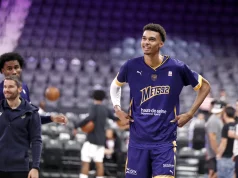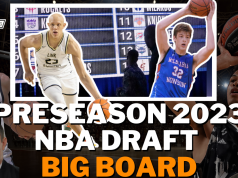In the San Antonio Spurs’ overtime loss to the Los Angeles Lakers last Wednesday, Dejounte Murray scored 11 of the Spurs’ 21 fourth-quarter points with his floaters in the paint, and by drawing fouls and collecting points at the free throw line.
This season, Murray’s primary shots he’s attempting are a layup or dunk at the rim, and if those shots aren’t available, he will take the floater over defenders. Overall, Murray is only making 55% of his shots at the rim, which places him in the 47th percentile among point guards. With his floaters, Murray is making 36% of his short mid-range shots, placing him in the 45th percentile among all point guards.
While Murray’s overall shooting in those two areas is below league average, he has started to become a more accurate shooter from those areas after the All-Star break.
Since the break, Murray is making 64.1% of his shots in the restricted area, a number slightly better than league average. Murray is also making 45% of his non-restricted (floater range) shots, which is almost 5% better than league average. Because Murray only makes 36.5% of his mid-range shots, he knows defenses will go under on screens, which means, if he’s aggressive, Murray can try to drive and get within the paint to hoist one of his floaters, which is going in more and more these days.
When it comes to the 3-ball, Murray is still reluctant to take shots from the outside. However, there has been a slight increase in his attempts from the corners after the All-Star break, where he’s making 41.7% of his corner 3s, a mark about 2% above league average.
Here are some of the shots Murray has been using to increase his accuracy from the rim, floater range, and corners.
In Transition
When Murray is on the floor, the Spurs see an increase in transition in both points per possession and frequency off steals and off live rebounds. In the open court, whether the ball is in his hands or he’s the recipient of an alley-oop pass, Murray is finishing more at the rim on the break.
Off the Ball
Since only 5% of Murray’s shots come from three, he typically stays near the rim off the ball for the chance at getting extra possessions with his offensive rebounding ability, or with his ability to cut when his defender tries to help off of him. Murray has collected 6.4% of the Spurs’ missed shots, placing him in the 100th percentile (elite) among point guards.
The Floater
Murray’s been going to the floater more often to get a scoring opportunity past the defense that’s closer than the typical mid-range shot. This season, Murray being within the paint and putting a floater up has a better chance of going in than his mid-range jump shot.
Corner 3
Before the All-Star break, Murray had only attempted 10 corner 3s and he had made two of those 10 attempts. Since the All-Star break, he’s been more willing to take the corner 3, where he’s made 5/12 corner 3s.
Since the All-Star break, Murray is getting to the free throw line more often too, attempting 2.4 free throw attempts per game. That makes him 3rd among Spurs players in free throw attempts after the All-Star break behind LaMarcus Aldridge and Pau Gasol. Murray is also the Spurs’ second-leading scorer in fourth quarters post All-Star break behind Aldridge.
While Murray has improved his accuracy on his shots at the rim and in the floater range, he must be ready for how defenses will game plan against him in the playoffs (should the Spurs qualify). Since the All-Star break, Murray has only made 12 of his 46 mid-range shots (26.1%) and he’s 0/3 on above the break 3s during that timeframe. The playoffs are the time when defenses have more time to create schemes that try to limit your strengths and force you to make plays with your weaknesses.
When it comes to his jump shot, there has been some criticism of Murray’s jump shot accuracy. While there’s still room for improvement, critics must keep in mind that Murray is only in Year 2 and he’s still just 21 years old.
When you compare Murray’s mid-range shooting numbers to those of Tony Parker in Year 2, they’re not that far off.
Murray’s Mid-Range in Year 2: 47/142 (33.1%)
Parker’s Mid-Range in Year 2: 91/265 (34.3%)
It took Parker until age 24 and year 5 of his NBA career to finish a season shooting over 50% from the floor. Basically, when it comes to Murray’s jump shooting development, time will be the ultimate evaluator in whether he improves, decreases, or stays the same.
While this post was mainly written to focus on Murray’s improved shooting at the rim and with the floater, there should be some recognition of some of his defensive highlights.
In a recent Spurscast episode, Collin Reid and I discussed why Murray has a pretty good chance of being selected to one of the All-NBA defensive teams this season. While Murray doesn’t have that ‘lockdown’ defender reputation of a Kawhi Leonard or Draymond Green, he has used his length and anticipation to deflect passes all over the floor this season and with his 6’5 height, he’s also able to block shots very well for a point guard.
Murray has blocked 0.9% of opposing shot attempts, which places him in the 91st percentile among point guards – elite status for the position. Murray has collected 2.3% of his team’s steals, which puts him in the 84th percentile among point guards (quite good). Lastly, when it comes to rebounding the ball, Murray has grabbed 20% of the opponents missed shots, placing him in the 98th percentile (elite) among point guards.
Finally, while they don’t play the same position, look at the steal and block numbers between Kawhi Leonard and Murray in Year 2 of their respective careers.
Kawhi Leonard in Year 2: 97 steals and 32 blocks in 1,810 minutes
Dejounte Murray in Year 2: 95 steals and 29 blocks in 1,699 minutes
Stats used for this article came from NBA.com/stats and CleaningTheGlass.com






